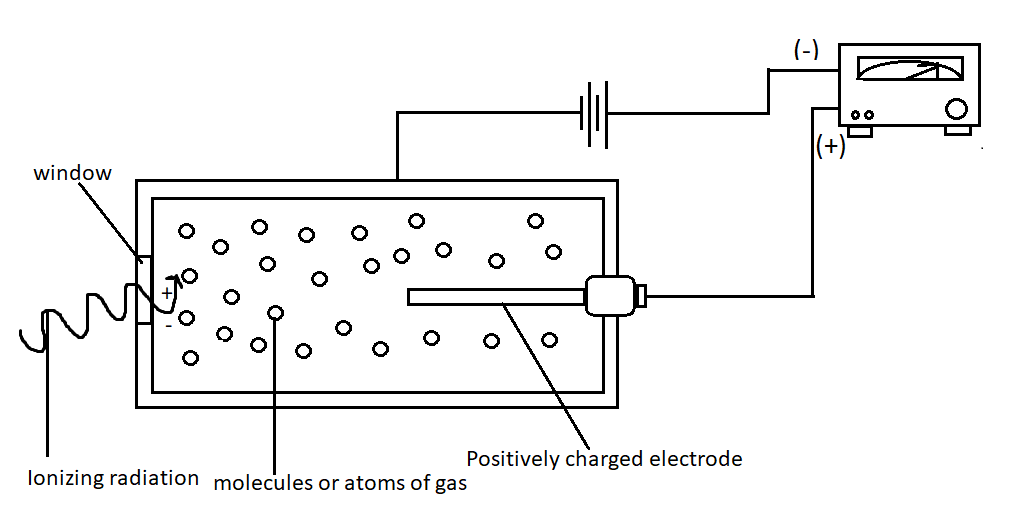
Explain the construction and working of a Geiger-Muller counter.
Answer
215.7k+ views
Hint A Geiger-Muller counter is a device used for the detection and measurement of ionizing radiation. It is mainly used for applications like the nuclear industry, radiological protection, radiation dosimetry, and experimental physics. It is one of the best devices for the detection of radiation, in the world.
Step by step solution

Construction:
The GM counter consists of a hollow metallic chamber as shown in the figure that acts as a cathode.
A thin wire anode is also placed along its axis.
The chamber has a sealed window, through which the radiation enters the chamber.
The chamber is filled with an inert gas at low pressure.
There is a counter connected to this system to measure the radiation.
Working
The chamber is filled with an inert gas (helium, neon, or argon) at low pressure. A high voltage is applied to this chamber. The metallic chamber will conduct electricity. When radiation enters the chamber through the window, the photons in the radiation will ionize the inert gas inside the chamber. This will make the gas conductive. The electrons produced due to ionization are accelerated due to the potential that we applied and these electrons cause even more ionization. The ionized electrons travel towards the anode. The anode is connected to a counter. The counter counts the electrons reaching the anode. This is how we measure radiation.
NoteThe major limitation of the Geiger Muller counter is that it does not have the ability to differentiate different types of radiations. Another major limitation is that it cannot measure high radiation rates. This is because, after each ionization, there will be a 'dead time’. This is an insensitive time during which further incident radiation does not count.
Step by step solution

Construction:
The GM counter consists of a hollow metallic chamber as shown in the figure that acts as a cathode.
A thin wire anode is also placed along its axis.
The chamber has a sealed window, through which the radiation enters the chamber.
The chamber is filled with an inert gas at low pressure.
There is a counter connected to this system to measure the radiation.
Working
The chamber is filled with an inert gas (helium, neon, or argon) at low pressure. A high voltage is applied to this chamber. The metallic chamber will conduct electricity. When radiation enters the chamber through the window, the photons in the radiation will ionize the inert gas inside the chamber. This will make the gas conductive. The electrons produced due to ionization are accelerated due to the potential that we applied and these electrons cause even more ionization. The ionized electrons travel towards the anode. The anode is connected to a counter. The counter counts the electrons reaching the anode. This is how we measure radiation.
NoteThe major limitation of the Geiger Muller counter is that it does not have the ability to differentiate different types of radiations. Another major limitation is that it cannot measure high radiation rates. This is because, after each ionization, there will be a 'dead time’. This is an insensitive time during which further incident radiation does not count.
Recently Updated Pages
JEE Atomic Structure and Chemical Bonding important Concepts and Tips

JEE Amino Acids and Peptides Important Concepts and Tips for Exam Preparation

Electricity and Magnetism Explained: Key Concepts & Applications

Chemical Properties of Hydrogen - Important Concepts for JEE Exam Preparation

JEE Energetics Important Concepts and Tips for Exam Preparation

JEE Isolation, Preparation and Properties of Non-metals Important Concepts and Tips for Exam Preparation

Trending doubts
JEE Main 2026: Application Form Open, Exam Dates, Syllabus, Eligibility & Question Papers

JEE Main Correction Window 2026 Session 1 Dates Announced - Edit Form Details, Dates and Link

Derivation of Equation of Trajectory Explained for Students

Hybridisation in Chemistry – Concept, Types & Applications

Understanding the Angle of Deviation in a Prism

Understanding Collisions: Types and Examples for Students

Other Pages
JEE Advanced Marks vs Ranks 2025: Understanding Category-wise Qualifying Marks and Previous Year Cut-offs

How to Convert a Galvanometer into an Ammeter or Voltmeter

Atomic Structure: Definition, Models, and Examples

Ideal and Non-Ideal Solutions Explained for Class 12 Chemistry

Degree of Dissociation: Meaning, Formula, Calculation & Uses

Understanding Electromagnetic Waves and Their Importance




